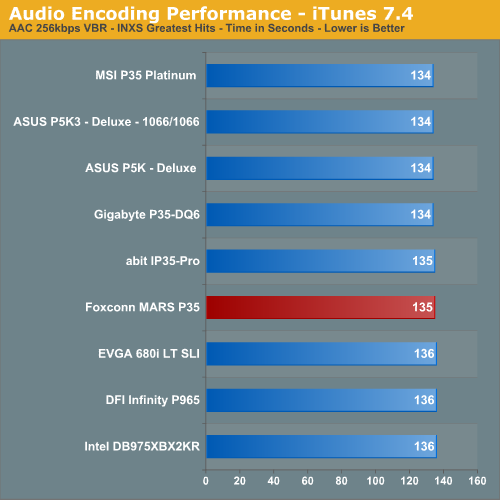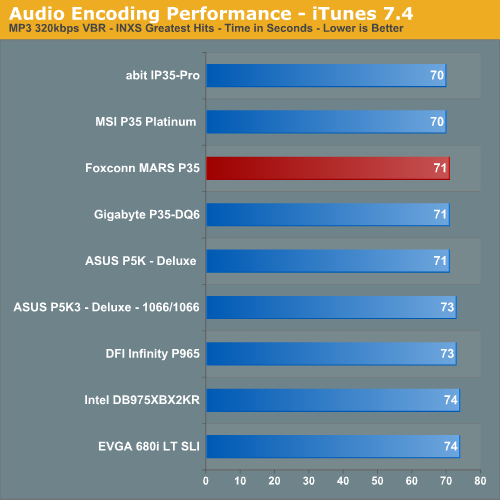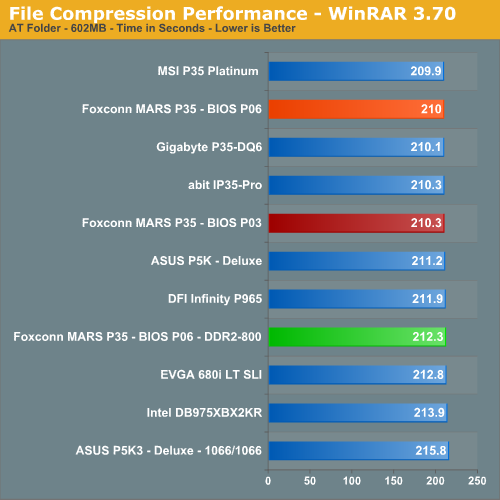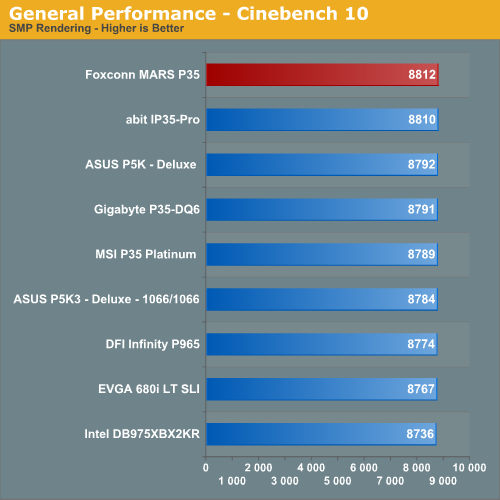Foxconn MARS: God of War Performance?
by Gary Key on September 21, 2007 12:00 PM EST- Posted in
- Motherboards
Audio Encoding Performance
We will utilize iTunes 7.4 for our audio encoding tests as it is one of the most utilized audio applications available due to the immense popularity of the iPod.
Our first task was to figure out what test CD to utilize. We needed one that contained a significant number of tracks and had over 600MB of data in order to properly stress our platforms. As in previous articles, we are using an INXS Greatest Hits CD for testing, which contains 16 tracks totaling 606MB of songs. Our next two tests have us utilizing iTunes to convert our WAV files into ACC or MP3 compatible formats. We utilize 320kbps or 256kbps and variable bit rate options for both tests.


We usually see iTunes favoring a system with excellent CPU throughput and these tests indicate the Foxconn board is up to speed in this area.
File Compression Performance
In order to save space on our hard drives and provide another CPU crunching utility, we utilize WinRAR 3.70 to perform some compression tests. WinRAR now fully supports multithreaded operations and should be of particular interest for those users with dual core or multi-processor systems. Our test folder contains 444 files, ten subfolders, and 602MB worth of data. All default settings are utilized in WinRAR and our hard drive is defragmented before each test.

Once again we see the Foxconn board performing well in a test that stresses overall memory latencies and CPU/Memory throughput. The nature of file compression is such that memory is accessed almost constantly in a very random fashion, so page misses requiring additional time as memory banks are swapped is common.
Rendering Performance
We are using the Cinebench 10 benchmark as it tends to heavily stress the CPU subsystem while performing graphics modeling and rendering. Cinebench 10 features two different benchmarks with one test utilizing a single core and the second test showcasing the power of multiple cores in rendering the benchmark image. We utilize the standard multi-core benchmark and default settings.

The Foxconn board performs extremely well in this CPU intensive test and leads our test group.
We will utilize iTunes 7.4 for our audio encoding tests as it is one of the most utilized audio applications available due to the immense popularity of the iPod.
Our first task was to figure out what test CD to utilize. We needed one that contained a significant number of tracks and had over 600MB of data in order to properly stress our platforms. As in previous articles, we are using an INXS Greatest Hits CD for testing, which contains 16 tracks totaling 606MB of songs. Our next two tests have us utilizing iTunes to convert our WAV files into ACC or MP3 compatible formats. We utilize 320kbps or 256kbps and variable bit rate options for both tests.


We usually see iTunes favoring a system with excellent CPU throughput and these tests indicate the Foxconn board is up to speed in this area.
File Compression Performance
In order to save space on our hard drives and provide another CPU crunching utility, we utilize WinRAR 3.70 to perform some compression tests. WinRAR now fully supports multithreaded operations and should be of particular interest for those users with dual core or multi-processor systems. Our test folder contains 444 files, ten subfolders, and 602MB worth of data. All default settings are utilized in WinRAR and our hard drive is defragmented before each test.

Once again we see the Foxconn board performing well in a test that stresses overall memory latencies and CPU/Memory throughput. The nature of file compression is such that memory is accessed almost constantly in a very random fashion, so page misses requiring additional time as memory banks are swapped is common.
Rendering Performance
We are using the Cinebench 10 benchmark as it tends to heavily stress the CPU subsystem while performing graphics modeling and rendering. Cinebench 10 features two different benchmarks with one test utilizing a single core and the second test showcasing the power of multiple cores in rendering the benchmark image. We utilize the standard multi-core benchmark and default settings.

The Foxconn board performs extremely well in this CPU intensive test and leads our test group.










17 Comments
View All Comments
Griswold - Sunday, September 23, 2007 - link
I see they also implemented the Northbridge<->PWM section cooling with heatpipes. Recipe for hot PWM with an Overclocked 4 core CPUHumbug. The PWMs with an overclocked quad will be hotter than a P35 NB - and they also can take alot more heat than a NB. Dont make issues up where there are none.
kmmatney - Saturday, September 22, 2007 - link
it seems like it would be better just to remove the covers over chipset heatsinks - don't they just reduce airflow? The coolpipe logo piece should just be taken off altogether.wolfman3k5 - Saturday, September 22, 2007 - link
Nice review, thanks allot! I want to buy one of these, where can I find this board?JarredWalton - Saturday, September 22, 2007 - link
Not out at retail quite yet - early next month I believe.cmdrdredd - Saturday, September 22, 2007 - link
Good board from the review, but it's a little late. Those who were looking to adopt P35 already have one of the other boards, everyone else wants to see X38. I suppose it would depend on the price of this board vs others once it hits actual retail channels.Griswold - Sunday, September 23, 2007 - link
Your world must be really small.strikeback03 - Monday, September 24, 2007 - link
Then again, didn't Gary Key say in the comments on the ASUS X38 board that he expects X38 to take over this market segment once initial hysteria wears off; as performance should be better than P35 for the same money. Then P35 would primarily work in the midrange.